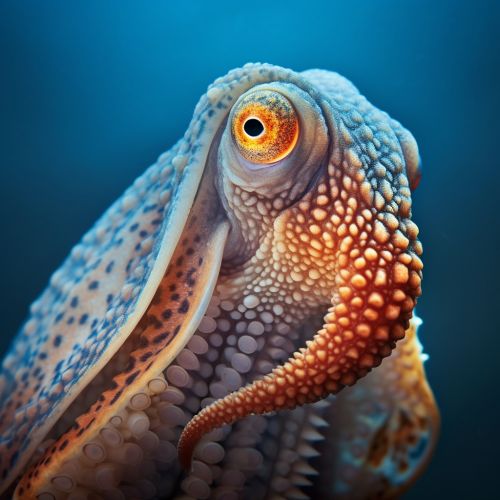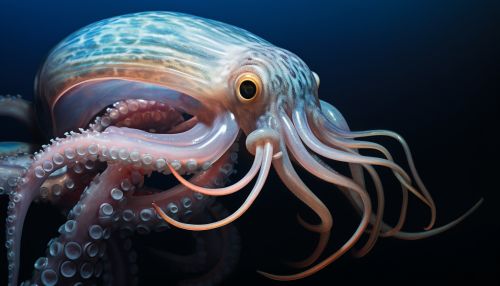Cephalopod
Introduction
Cephalopods are a class of marine Mollusca that includes several well-known and widely studied species such as squids, octopuses, and cuttlefishes. They are characterized by bilateral body symmetry, a prominent head, and a set of arms or tentacles modified from the primitive molluscan foot. Cephalopods are among the most intelligent and behaviorally complex of all invertebrates.


Anatomy and Physiology
Cephalopods have a complex and highly developed anatomy. Their main body mass is enclosed in the mantle, which has a swimming fin along each side. The skin is covered in chromatophores, which allow the cephalopod to change its skin color and patterns quickly. The cephalopod eye is remarkably similar to the human eye, allowing for acute vision.
Cephalopods have two gills, which are used for respiration. The heart pumps blood to the gills, where it is oxygenated, and then to the body of the animal. The blood contains the copper-rich protein hemocyanin, which is more efficient than hemoglobin in cold, low-oxygen waters.
The nervous system of cephalopods is the most complex of the invertebrates and their brain-to-body-mass ratio falls between that of endothermic and ectothermic vertebrates. They are capable of learning, and possess short- and long-term memory.
Behavior and Ecology
Cephalopods are found in all the world's oceans, from the tropics to the poles, and from the shallows to the abyss. They are a significant component of the marine food web, serving as prey for many species and predators of others.
Cephalopods are known for their behavioral sophistication, which includes complex problem-solving and social interactions. They are capable of rapid color change for communication and camouflage. Some species are known to use tools, and others exhibit play behavior.
Many cephalopods are semelparous, meaning they reproduce once and then die. The male typically uses a specially adapted arm to deliver a bundle of sperm into the female's mantle cavity, after which the female lays a large number of eggs.
Evolution and Classification
Cephalopods are thought to have evolved from a common ancestor with other mollusks during the late Cambrian period, around 540 million years ago. The class Cephalopoda includes two main subclasses: the Nautiloidea, with a single extant family, the Nautilidae (represented by the pearly nautilus), and the Coleoidea, which includes octopuses, squids, and cuttlefish.
Human Interaction
Cephalopods have been featured in literature and folklore since ancient times, notably in the Greek myth of the giant squid-like monster, the Kraken. They are also a common subject in modern science fiction, often depicted as large, intelligent, and aggressive predators.
Cephalopods are also an important food source for humans, particularly in Mediterranean and Asian cuisines. Squid and octopus are common ingredients in dishes such as calamari and takoyaki.
Conservation
While some cephalopod species are of least concern, others face threats from habitat destruction, pollution, and overfishing. Conservation efforts for cephalopods are ongoing, with research focused on understanding their biology and ecology to inform management strategies.
